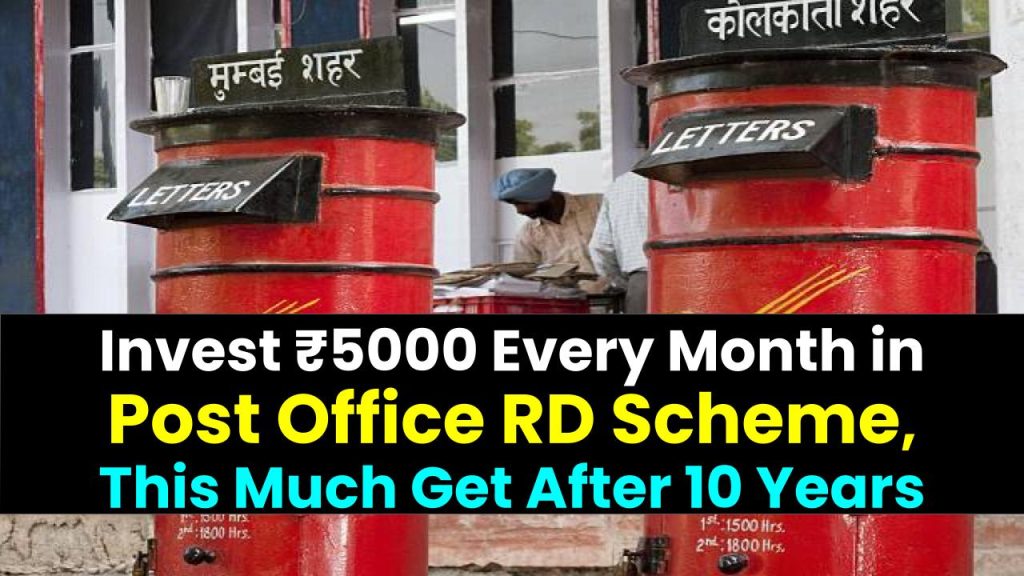
Investing in the Post Office RD (Recurring Deposit) scheme is one of the safest ways to build wealth steadily. If you invest ₹5000 every month in this government-backed scheme, you may be wondering: “How much money will I receive after 10 years?” The answer is more impressive than you might expect.
In this article, we break down everything you need to know about the Post Office RD scheme, how much you’ll earn if you invest monthly, and why this scheme is a smart choice for long-term savers. Whether you’re a first-time investor or a financial professional advising client, this guide has you covered.
Post Office RD Scheme
| Feature | Details |
|---|---|
| Monthly Investment | ₹5000 |
| Tenure | 10 Years (can be extended from default 5-year tenure) |
| Interest Rate (April 2025) | 6.7% per annum, compounded quarterly |
| Total Investment | ₹6,00,000 |
| Estimated Maturity Amount | ₹8,32,000 (approx.) |
| Total Interest Earned | ~₹2,32,000 |
| Scheme Type | Government-backed Recurring Deposit (RD) |
| Official Website | India Post |
Investing ₹5000 every month in the Post Office RD scheme for 10 years can help you accumulate a guaranteed corpus of over ₹8.3 lakh, with zero market risk. It’s a perfect plan for those seeking stability, regular savings, and long-term security.
What Is the Post Office RD Scheme?
The Post Office Recurring Deposit (RD) scheme is a savings plan offered by India Post under the Department of Posts. It encourages monthly savings and provides a fixed return over time. It’s especially popular among conservative investors, senior citizens, and parents saving for children.
Key Features of Post Office RD
- Minimum deposit: ₹100 per month
- Maximum: No upper limit
- Tenure: Default 5 years; can be extended in 5-year blocks
- Interest Rate: 6.7% p.a. (as of Q1 FY 2025-26)
- Compounding Frequency: Quarterly
- Guaranteed returns: Backed by the Government of India
see also: What will be the EMI on a home loan of ₹5 lakh?
How Much Will You Get After 10 Years?
Let’s walk through a detailed example to help you understand the numbers.
Investment Example
- Monthly deposit: ₹5000
- Tenure: 10 years (120 months)
- Interest Rate: 6.7% annually, compounded quarterly
Formula Used
The maturity amount in an RD scheme is calculated using a compound interest formula:
M = R × (1 + i)^n – 1 / (1 – (1 + i)^(-1/3))
Where:
- R = Monthly deposit
- i = Quarterly interest rate
- n = Total quarters
Calculation
- Quarterly interest rate = 6.7% / 4 = 1.675%
- Total quarters = 10 years × 4 = 40
- Estimated maturity = ~₹8,32,000
- Total amount invested = ₹5000 × 120 = ₹6,00,000
- Interest earned = ~₹2,32,000
These returns are guaranteed and not affected by market volatility, making the scheme ideal for risk-averse investors.
Why Choose Post Office RD for Long-Term Investment?
Benefits
- Safe and secure: Backed by the Indian government
- Regular saving habit: Perfect for disciplined investors
- Attractive interest rate: Higher than many bank RDs
- No TDS deduction: Unlike bank RDs, there is no TDS deducted at source (though interest is taxable as per income slab)
Who Should Invest?
- Parents planning for their child’s education
- Young professionals beginning their investment journey
- Senior citizens looking for secure income
- Salaried individuals who prefer small, regular savings
How to Open a Post Office RD Account
Opening a Post Office RD account is simple and convenient:
Step-by-Step Guide
- Visit your nearest post office or open an account online via India Post Online Services.
- Fill out the RD account form and provide KYC documents (Aadhaar, PAN, passport-size photo).
- Deposit your first installment (minimum ₹100).
- Receive your passbook or track your account digitally.
Taxation on Post Office RD Earnings
While the Post Office does not deduct TDS on interest earned from RD accounts, you must still report it in your income tax return.
Important Points
- Interest is taxable: Under “Income from Other Sources”
- No 80C benefit: RD investments do not qualify for deductions
- No TDS: You get the full maturity amount, but pay tax later
To optimize taxes, consider spreading RD maturity across financial years or investing in tax-saving instruments alongside.
Alternatives to Post Office RD
Here are some other options you can compare:
| Scheme | Interest Rate (April 2025) | Tenure | Risk | Tax Benefit |
|---|---|---|---|---|
| SBI RD | ~6.5% | 1-10 years | Low | No |
| PPF | 7.1% | 15 years | Very Low | Yes (80C) |
| NSC | 7.7% | 5 years | Very Low | Yes (80C) |
| Fixed Deposits (Banks) | 6.5%-7.5% | Varies | Low | Partial (TDS applies) |
While PPF and NSC offer tax benefits, they have limited liquidity. For monthly savers seeking fixed, mid-term returns, Post Office RD stands out.
see also: Canara Bank FD: Invest 1 to 5 lakh and see how much return you will get
Post Office RD Scheme FAQs
Q1: Can I invest more than ₹5000 in Post Office RD?
Yes, you can. There is no upper limit. You can open multiple RD accounts or invest higher monthly amounts.
Q2: Can I withdraw the money before 5 or 10 years?
Premature withdrawals are allowed after 3 years but come with reduced interest rates.
Q3: Is the interest rate fixed for 10 years?
No, interest is revised quarterly by the government. If you extend beyond 5 years, the new interest rate will apply to the extended period.
Q4: Can I open an RD account online?
Yes, if you have a post office savings account with internet banking access.
Q5: What happens if I miss a monthly payment?
You can still deposit within the allowed grace period. However, a small penalty of ₹1 per ₹100 per month may apply.











